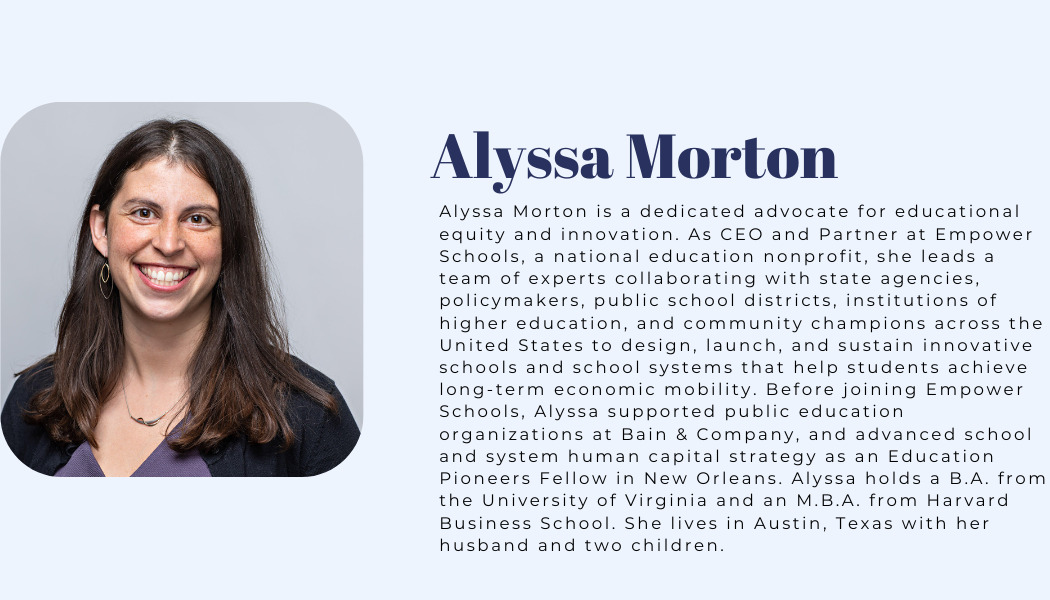
Across the country, forward thinking districts are creating the conditions for innovative schools to thrive and endure inside the public school district system. Through a combination of state enabling laws and local initiative, these innovative schools are able to meet student and family needs while empowering and retaining excellent educators and school leaders. There are talented educators all over the nation with deep expertise and innovative ideas, and there are communities in every state who are demanding better public school options for their children. What we lack at scale is the systems and conditions inside our public school districts to support these educators and enable the creation and sustainability of these schools that communities are asking for.

How Innovation Schools Work
Innovation schools and innovation zones (a cluster of innovation schools operating as a group) are public district schools granted flexibility from district policy and/or state law to customize the educational experience for the students of their community. Flexibility comes in the form of autonomy to make decisions around budgeting, staffing, scheduling, and curriculum, empowering school leaders with the authority to reimagine the school experience. Each innovation school is designed by the educators, families, and students in the community – the models are as diverse as the public school system itself. In some communities, innovation schools have adopted high-demand models like dual-language, International Baccalaureate (IB), community schools, and Montessori. In others, these schools and zones use time in new ways, with year-round school schedules or longer school days with expanded extracurriculars.
Many innovation schools and zones have reimagined the role of educators – they allow for new and different roles for master teachers, instructional coaches, teacher residents and apprentices, counselors and mental health professionals, and college and career counselors. Several innovation schools feature robust postsecondary pathways from which students graduate with college degrees, industry certifications, and the connections they need to continue to grow in their chosen professional fields.
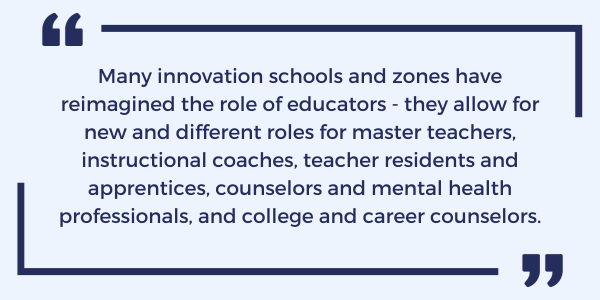
Designing Sustainable Innovation
To be sure, many district leaders have announced over the years that their schools are now innovative or empowered. Too often, however, the decisions underlying this flexibility are reversed by a shift in school board leadership or a transition in superintendency. Some districts announce that schools can make decisions or adopt new models, but then middle managers at central offices continue to demand compliance and conformity from school leadership teams. It is difficult to design sustainable innovation inside of school districts; in fact, many educators, school leaders, and system leaders have given up trying and have opted to cultivate new models outside of the school district.
There is an alternative. If intentionally structured to withstand the forces that undermine their integrity, innovation schools can persist, nimbly respond to evolving needs, and get better and better over time. Educators and policymakers are seizing this opportunity across the nation.
The first step in their journey is to recognize that, absent structural innovation, school-level innovation soon withers. The traditional district was not designed to cultivate and support the diversity of school models our students need and our families demand. These structural innovations are happening across the country, sometimes via enabling legislation and protective regulation, and other times by entrepreneurial equity-driven education leaders who are charting new paths in their own communities.
These are not hypothetical or aspirational initiatives. The innovation school structure has been designed and refined to respond systematically to the challenges that have doomed innovation inside the district setting – initiative fatigue, leadership turnover, and bureaucratic red tape. While the regulatory pathways differ state to state, each framework includes core components that together ensure that innovation schools and innovation zones retain both the flexibility and autonomy granted in exchange for their commitment to, and accountability for, ambitious student outcomes:
- Nonprofit governance: Innovation schools and zones are governed by a nonprofit board, to which the school district board delegates authority. The nonprofit board is typically made up of a diverse group of community members, and in some states also includes representatives of city government or the school district. The nonprofit board protects these schools from arbitrary shifts in strategy and leadership changes, advocating for the schools’ needs and allowing the schools to continuously improve and sustain what’s working.
- Flexibility to innovate: Innovation schools and zones operate under unique structural conditions which give them the opportunity to make school design decisions around staffing and human capital, schedule and calendar, budget allocation, school culture and climate, and academic programming. Where applicable, innovation schools negotiate customized collective bargaining agreements that empower educators at the school level to have a leadership role in the school’s plan and direction.
- Performance contract: Innovation schools and zones are held accountable to meeting ambitious student outcome goals outlined in a performance contract. These agreements include rigorous accountability measures that are aligned with state and district requirements, as well as measures that reflect a community’s broader definition of success, including postsecondary and life outcomes of students, and attention to the needs of the whole child. The contract is structured such that innovation schools and zones can continue to operate with flexibility as long as they are meeting the agreed-upon outcomes for students.

A National Trend
Innovation schools are gaining traction across the United States, serving as incubators for educational change. In urban, suburban, and rural settings, these schools are proactive responses to the specific needs of their communities, demonstrating that, regardless of geography or demographics, a well-implemented innovation school can serve as a catalyst for improved student outcomes and community ownership.
In Indianapolis, 31 of the district’s 77 campuses are Innovation Network Schools, serving more than 13,000 students. Indianapolis Public Schools (IPS) explains that, “These schools operate with the fullest level of flexibility IPS offers and are an integral part of the district fabric, helping ensure there is a quality school in every neighborhood.“ These schools have been operating with unique flexibility since 2015, and in a rigorous study by the Center for Research on Education Outcomes at Stanford University (CREDO) conducted in 2018-19 (the last year of comparable data before COVID), researchers found that students at Innovation Network Schools achieved growth equivalent to 38 days of additional learning in ELA and 47 days of additional learning in math relative to students in direct-run IPS schools. The gains were even stronger for Black students, with growth equivalent to 69 days of additional learning in ELA and 80 days of additional learning in math relative to Black students in Indianapolis traditional public schools.
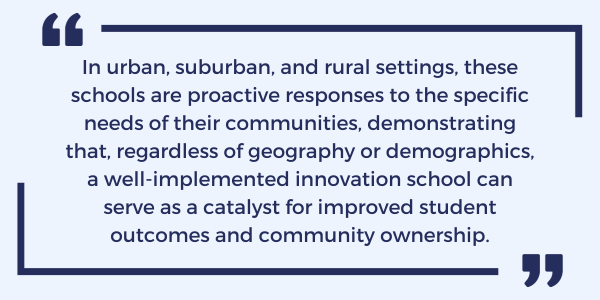
In Springfield, Massachusetts, the Springfield Empowerment Zone Partnership (SEZP) has operated for nine years, revitalizing some of the state’s most historically underperforming schools. Launched as a partnership between the Springfield Public Schools, the Springfield Educators Association (SEA), and the Massachusetts Department of Elementary and Secondary Education, the Zone has expanded to 16 schools, each embodying a unique model created by educators in partnership with their communities.
SEZP’s customized union contract, which is separate from the district’s traditional union contract, creates a robust teacher leadership team structure for decision-making, removing traditional contractual work rules and empowering teachers at each campus. When this customized collective bargaining agreement came up for renewal, 96% of the Zone’s teachers voted to continue the structure. The outcomes in Springfield contain some real bright spots. Improvements within SEZP’s middle schools have driven impressive growth in graduation rates across both Springfield’s innovation and traditional public high schools. Over the past nine years since the zone was launched, the overall high school graduation rate in Springfield has increased from 62% to 85%. One notable driver of this increase is SEZP’s innovative early college academy model – launched in 2016 to change the trajectory of a large, historically underperforming high school – which has raised that school’s graduation rate from 47% in 2015 to 84% in 2022.
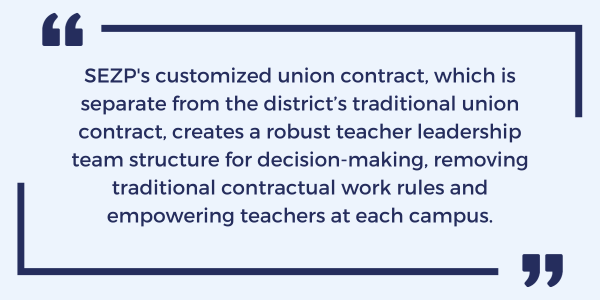
In San Antonio, Texas, Centers for Applied Science and Technology (CAST Schools) runs six innovation schools serving pre-kindergarten through 12th grade students. At each CAST school, academics are integrated with career and technical education in a curriculum that combines project-based, personalized, and work-based learning. The schools in the network aim to deliver economic mobility for San Antonio students, expanding access to college, exposure to careers, and connections to industry-based mentors. CAST schools feature different career themes aligned to San Antonio’s high-wage, high-demand industries, including medicine, education, technology and business, engineering and global logistics, and hospitality and ecommerce. By leveraging some services from the district that require economies of scale (e.g., transportation) and customizing the model in other areas (e.g., calendar and schedule, staffing model and professional development), CAST schools create a tailored experience for their students and staff alike. In the latest round of accountability scores, these schools all received A and B grades; CAST students are significantly more likely to graduate with academic proficiency, work-based learning experiences, and college credit compared to their peers in traditional public schools.
There are now hundreds of innovation schools across multiple states, thriving in a wide variety of demographic and political environments. What’s special about these innovation schools is that they combine the democratic voice and economies of scale of public school districts with the flexibility and innovation that has traditionally been seen as only possible in private schools and public charter schools. Research from CREDO,CU Denver, and the Progressive Policy Institute show that the innovation school framework is achieving results. Across a wide variety of contexts and school types, innovation schools are retaining great principals, unlocking the talent and creativity of teachers, creating innovative learning environments for students, and achieving accelerated academic and life outcomes for students.
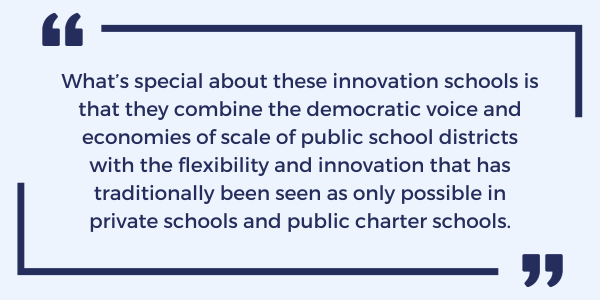
How more communities can create effective innovation schools
As the CEO of Empower Schools, I lead a team of educators and experts working closely with innovation schools and zones across five states. We catalyze and support the growth of these new structures in the context of their communities and state policy frameworks. We’ve learned that effective innovation schools and zones are most supported when there is both state-level enabling policy and local ownership of the model.
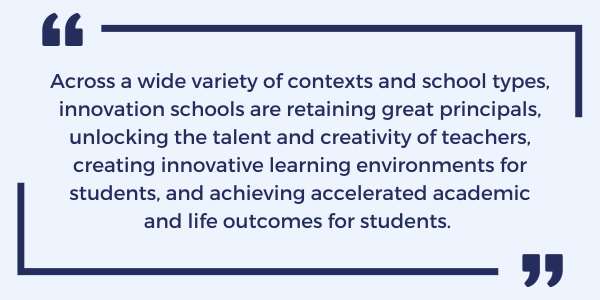
State education agencies, legislators, and other elected leaders play a critical role in creating the conditions for innovation schools to thrive and scale in each state. Indiana, South Carolina, and Texas feature different enabling policies with the common objective of incentivizing, protecting, and strengthening innovation schools across the state. In Texas, which now has more than 100 innovation schools serving more than 45,000 students, the state legislature has incentivized the model through an additional per-pupil allotment for innovation school students. The State Education Agency has built upon this foundation, rolling out the infrastructure necessary to train and provide technical assistance to district teams and entrepreneurial school leaders who step up to design and launch innovation schools across the state.
District leaders – school board members and superintendents specifically – play an equally important role in cultivating innovation schools and zones. School boards can adopt policies and solicit proposals for innovation school models that fit the needs of their community. Once an innovation school plan is proposed, the board exercises its governance authority by approving the creation of the innovation school or zone, as well as the performance contract that formalizes the real autonomy and real accountability that undergird the structure.
Superintendents and central office leaders can also catalyze strong innovation schools by supporting high-performing, innovative district schools to convert, replicate, or expand through an innovation school structure. This process of conversion and expansion can empower the district’s best educators and school leaders and protect them from future changes in strategy or leadership. In an environment of school district enrollment declines, system leaders find the innovation school model to be a powerful way to attract families, retain educators and school leaders, and accelerate success in district schools. San Antonio ISD, for example, has more than 1,200 students transferring into the district across district lines to attend its innovation schools, several of which have waitlists.
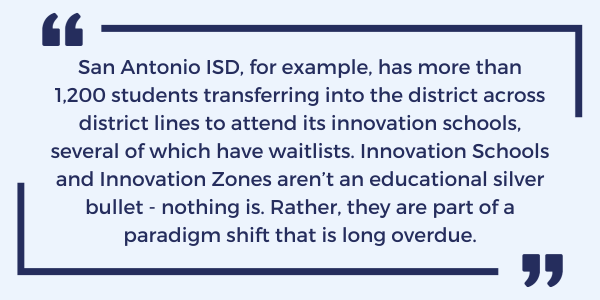
Innovation Schools and Innovation Zones aren’t an educational silver bullet – nothing is. Rather, they are part of a paradigm shift that is long overdue. Implementation has been fraught at times, as with any innovation that is more than marginal, but it is a change worth making, and one with potential to scale. The evidence is in the schools that are achieving standard outcomes measured by test scores and graduation rates, while also excelling in other indicators of success such as student and family satisfaction, school climate and culture, staff retention, and postsecondary outcomes. Together, these measures tell a story of deepening and more hopeful relationships between communities and their district schools.
As state, city, and school district leaders are confronted with increasingly polarized perspectives about the relevance and efficacy of the school district as an education delivery system, they would do well to embrace the innovation school structure as a part of a broader policy agenda. When properly designed, the structure will enable and protect vibrant schools within the public school district system on which the vast majority of students rely. It’s time for states and districts to meet the moment, and the innovation school structure is a tool they can use to enable communities to have the schools they want with the results students need.
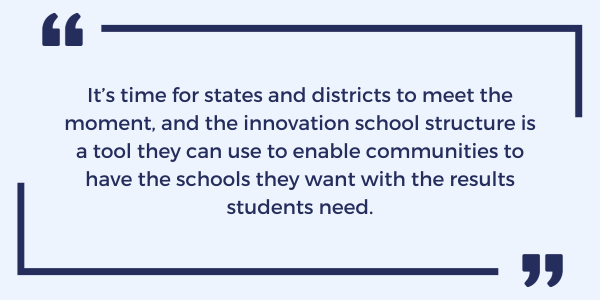
If you want to learn more about the laws and policies that have authorized the creation of innovation zones, please access the materials below:
- Texas SB1882 Partnerships Law
- Texas SB1882 State Agency Information / Additional Information
- Indiana Innovation Schools Legislation
To learn more about innovation zones in action, check out this article on CAST innovation schools in San Antonio by ERN Policy Analyst Rianna Saslow.